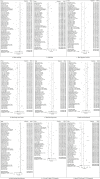Demographic and socioeconomic inequalities in ideal cardiovascular health: A systematic review and meta-analysis
- PMID: 34379696
- PMCID: PMC8357101
- DOI: 10.1371/journal.pone.0255959
Demographic and socioeconomic inequalities in ideal cardiovascular health: A systematic review and meta-analysis
Abstract
Background: In 2010, the American Heart Association introduced a new concept of ideal cardiovascular health (CVH) defined as the simultaneous presence of 7 favorable CVH metrics (smoking, diet, physical activity, body mass index, blood pressure, total cholesterol, and fasting blood glucose). The objective of this study was to conduct a systematic literature review and meta-analysis of studies examining the prevalence of ideal CVH, and each of the ideal CVH metrics as well as the relationship between socio-demographic determinants and ideal CVH.
Methods: A comprehensive literature search was conducted in Medline and Scopus databases for studies published between 1 January 2010 and 30 June 2020. A total of 50 studies including 2,148,470 participants were analyzed. Associations were estimated using DerSimonian-Laird random-effect models. Heterogeneity was investigated through subgroup analyses, Q-test, and I2 statistics.
Results: This study showed a low prevalence of ideal CVH defining as 6 and 7 ideal metrics (3.3%). Among seven ideal CVH metrics, smoking was the best metric (71%), while the poorest CVH metric was a healthy diet (5.8%). Gender was a statistically significant moderator of ideal smoking (81% in females and 60% in males) and ideal blood pressure (42% in females and 30% in males). Females and young adults had better CVH status compared to males and older adults. Also, more educated and better-off individuals had a greater number of ideal CVH metrics.
Conclusions: To the best of our knowledge, this is the first systematic review on the relationship between participants' socioeconomic status and ideal CVH. The results suggest that the prevalence of ideal CVH and most metrics was unsatisfactory. In order to achieve the improvement of the CVH metrics and the overall ideal CVH, nationwide prevention efforts at the population and individual levels are urgently needed.
Conflict of interest statement
The authors have declared that no competing interests exist.
Figures



References
-
- Lloyd-Jones DM, Hong Y, Labarthe D, Mozaffarian D, Appel LJ, Van Horn L, et al.. Defining and setting national goals for cardiovascular health promotion and disease reduction: The american heart association’s strategic impact goal through 2020 and beyond. Circulation. 2010;121: 586–613. doi: 10.1161/CIRCULATIONAHA.109.192703 - DOI - PubMed
-
- Folsom AR, Yatsuya H, Nettleton JA, Lutsey PL, Cushman M, Rosamond WD. Community prevalence of ideal cardiovascular health, by the american heart association definition, and relationship with cardiovascular disease incidence. J Am Coll Cardiol. 2011;57: 1690–1696. doi: 10.1016/j.jacc.2010.11.041 - DOI - PMC - PubMed
Publication types
MeSH terms
LinkOut - more resources
Full Text Sources
Medical

